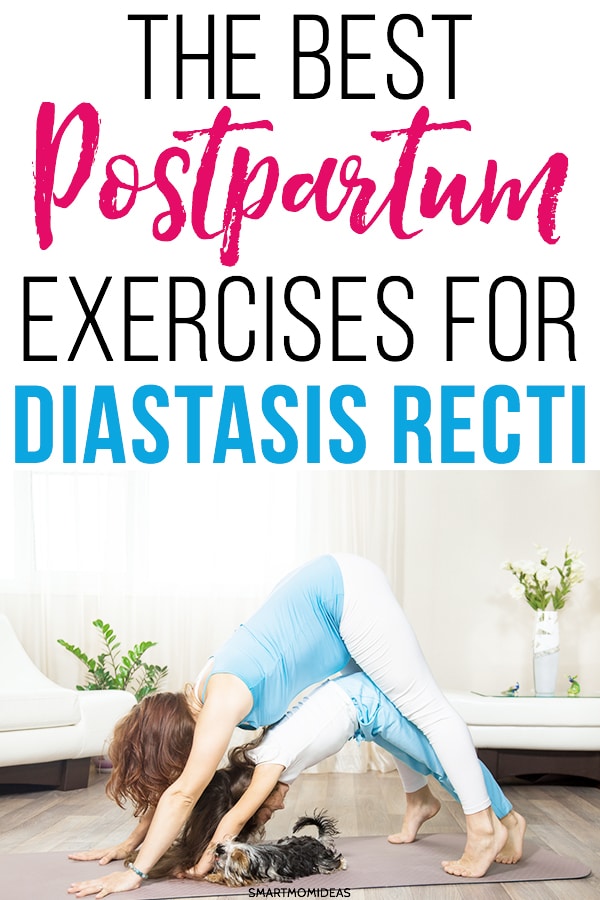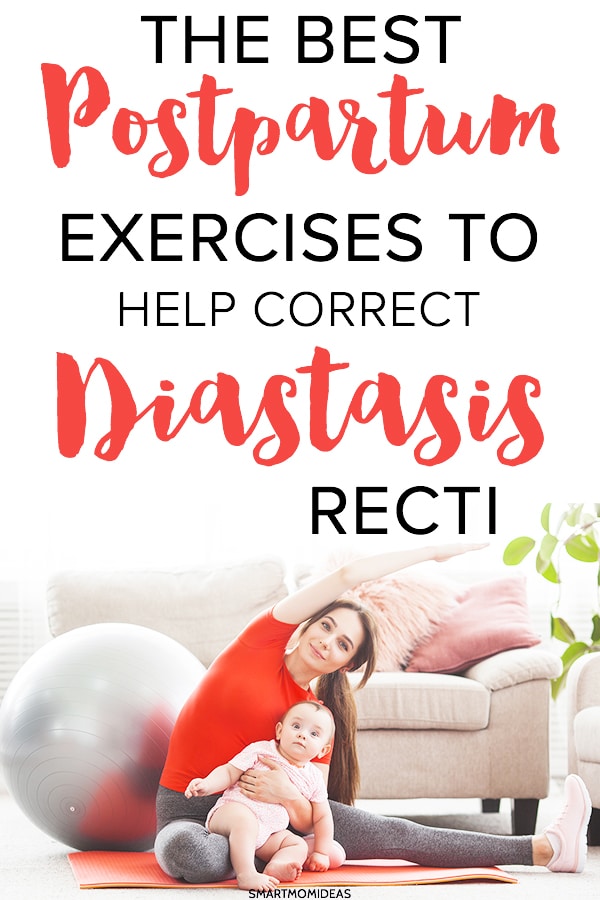Heal your body with these postpartum exercises for Diastasis Recti

Let’s face it, after giving birth your body is never going to be the same.
Your boobs are going to be saggier, your hormones are out of whack for quite some time, and your tummy muscles are probably non existent.
While it can take a lot longer than nine months to get your six pack back (if you were lucky enough to have one in the first place), things like diastasis recti can really make it difficult to get your tummy back to its pre-pregnancy state.
Your stomach muscles run parallel in your stomach and during pregnancy they can actually separate, resulting in diastasis recti.
For many women, this results in a pregnancy pooch or still looking like you are pregnant long after you have delivered.
However, there are many different exercises that you can do that will help to correct diastasis recti and get you closer to your flat tummy goals.
How To Test If You Have Diastasis Recti
First of all, you should make sure that you have diastasis recti.
Exercising your core muscles is great whether you have it or not, but knowing for sure that you do will help to focus on doing the right exercises to help correct this condition.
Let’s get scientific for a minute here. Your stomach is made up to two main muscles on the right and left sides of your abdomen called the rectus abdominis. These are held together by connective tissue known as the linea alba.
When you check for diastasis recti, you should feel above and below the belly button for the depth of depression and the width of separation.
Lay on the ground like you are going to do a crunch and place two fingers first vertically above the belly button, then horizontally. Then repeat below the belly button. You can also see your doctor to get a clinical diagnosis.
In the video below, Dr. Monique Middlekauff shows you exactly how to check for diastasis recti.
When you are doing exercises to fix your diastasis recti you don’t want to do things that are high intensity and cause a lot of stretching in your abdominal muscles. This can actually make your diastasis recti worse.
You want to work on slow and controlled movements that will help to pull those muscles back together.
You are going to want to focus on the deepest muscles first rather than the ones closer to the service.
How To Draw In
One thing that you have to remember when you are working on your diastasis recti is that you need to pull your belly in, or “draw in.”
Not just like you are sucking in to look thinner, but imagine that you have a string on the inside of your belly button that is being pulled up towards your head. It is more of an in and up motion rather than just pulling your belly straight back.
This should be done with just about every other move listed below.
Pelvic Tilt
The pelvic tilt is a great exercise to start with.
Simply lay on your back with your knees up and feet flat on the floor with your arms relaxed beside you. The goal here is to be able to draw your stomach muscles in while you are slightly tilting your pelvis.
Keep your hips and your buttocks relaxed and while tilting your up, draw your spine and belly to the floor. This happens on the exhale.
Then when you tilt your pelvis down, lengthen your core and take a deep breathe in. Do this move for about 10 to 20 reps then take a minute or two to rest before starting the next exercise.
Leg Slide
This is another slow and controlled movement that is very easy to do and will help to engage your core muscles.
Lay flat on the floor with your arms relaxed at your sides and your spine in a neutral position.
While you draw your belly in, slide your right leg so your knee reaches a 90 degree angle while your heel remains on the floor during the whole motion. Then return your leg back to its original position flat on the floor.
Do this with your left leg then return to the original position of a neutral spine.
One movement from each leg (one right and one left) counts as a rep. Do 10 to 15 reps of this move.
Pillow Squeeze
Grab yourself a thicker pillow and lay on the floor. Lay in the same position as you did with the pelvic tilts, flat on your back with your arms relaxed beside you and a neutral spine.
Gently place the pillows between your knees while they are raised up at approximately a 90 degree angle.
While drawing in and engaging your core, squeeze your knees together and hold for about 6 to 10 seconds.
If you can’t do a whole 10 seconds just hold it as long as you can. Make sure that you are breathing out while you are squeezing your knees and not holding your breath.
Bridge Lift
Lay down in your position again where you are flat on the floor and your knees are just about 90 degrees.
Your arms should be relaxed beside you and your spine in neutral. You are going to want your feet to be a little less than shoulder width apart.
First take a deep breath inward drawing your stomach muscles in and making sure there is no arch in your back.
Then, as you exhale, raise your butt to the ceiling while keeping your core engaged. Use your arms to stabilize you and hold for three to five seconds.
As you come down, roll your spine down one vertebrate at a time and exhale. If you are good at multitasking, you can also squeeze your pelvic muscles and do kegel exercises as well.
Dead Bug
Lay flat on your back and bring your knees up so both your knees and your hips are at a 90 degree angle. Make sure you aren’t bringing your knees too close to your chest and that your spine is in a neutral position.
Then raise your arms up so they are also at a 90 degree angle with your back.
It might even be difficult for you to maintain this position and that’s ok.
If you find this position to be challenging, then stay in the start position while drawing your belly in and just breathing.
The dead bug has several different moves that are incorporated into it.
First you can start by moving just one arm down so that it is straight above your head with your shoulder to your ear.
Move your arm down on the exhale and repeat on the other side going back and forth a few times while maintaining a 90 degree angle with your knees and hips.
The next part of this move that you can do is to move your legs. Take one leg and bring it down, maintaining a 90 degree bend in the knee and bringing your foot flat to the floor, then raising it up again. Alternate your legs just like you alternate your arms.
Always move your arms and legs on the exhale and bring them back to position when you inhale.
The most challenging move is to move an opposite arm and leg.
For example, your right arm is extended above your head with your shoulder to your ear and your left leg is extended down. You then return to the position lying on your back with your arms and legs up.
Then alternate with the other arm and leg.
If you want to really kick things up a notch, then hold a dumbbell in the arm that remains straight up.
Side Plank With Hip Lift
This is a great exercise to not only heal your diastasis rectis but also to work on your obliques (or love handles).
Lie on your side with your knees bend backwards at a 90 degree angle (or straight out if you are comfortable with that). Then rest your weight on your palm which should be flat on the floor.
Raise your hips towards the ceiling and exhale. When you bring your hips back down, inhale and draw your belly in.
What Exercises To Not Do
Again, you don’t want to put too much stress on those tummy muscles when you are trying to heal your diastasis recti.
Rather than focusing on building up the front tummy muscles, you want to work from the inside out and work on the transverse abdominals, or the muscles that connect your back and your stomach.
Here is a quick list of exercises that you should be avoiding:
- Crunches
- Sit ups
- Plank
- Twists
- Jackknives
- Leg lifts
These all put too much strain on the connective tissue that is holding your abdominal muscles together and the muscles themselves.
You also want to make sure that you are not getting up and down (while doing your exercises or getting up off the floor) and engaging your abdominals too much like you would in a situp.
Doing these exercises on a regular basis should help to heal your diastasis recti and get you closer to that flat belly.





Leave a Reply